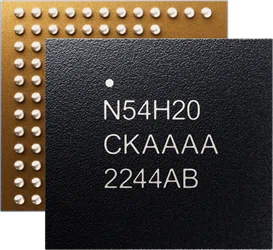New ranging features
Unlock new application areas and explore enhanced possibilities for existing products with reliable and accurate ranging capabilities, effective over both short and longer distances.
Bluetooth Channel Sounding is a key feature of the Bluetooth core specification 6.0. It enables accurate and secure distance measuring with built-in security features and seamless interoperability. The nRF54L Series has official support for Channel Sounding, with a Bluetooth qualified host and controller available in nRF Connect SDK v3.0.1.
Nordic Distance Toolbox (NDT) is an alternative proprietary ranging solution from Nordic based on well-proven measurement methods. The nRF52 and nRF53 Series support NDT.
-
Initiator with embedded ranging algorithm
In Bluetooth Channel Sounding, Initiators contain the application-level algorithm that converts the raw data included from the Bluetooth PHY and stack into a distance measurement. Nordic Semiconductor's Channel Sounding Initiator with ranging requestor sample contain an open and free-to-use IFFT algorithm suitable for simple ranging use cases.
For more advanced ranging, Nordic Semiconductor collaborates with partner companies that offers tailor-made algorithms for use in applications like trilateration for indoor positioning systems.
-
Reflector with universal compatibility
Channel Sounding Reflectors respond to the exchange by reflecting tones sent by the initiator. Nordic Semiconductors Channel Sounding Reflector with ranging responder sample is Bluetooth qualified with the DN from nRF Connect SDK v3.0.1 and onwards. This means you can build this sample today and interact with any Channel Sounding Initiator that follows the specification.
Most embedded devices that connects to a mobile phone will take the role of reflector in this relationship if Bluetooth Channel Sounding is included.
Bluetooth Channel Sounding
Supported roles
Watch it in action
Channel Sounding demo
Channel Sounding and phones
While this technology can be implemented on any Bluetooth 6.0 device, mobile phones are expected to primarily boost the adoption of Channel Sounding. Phones are set to manage the algorithmic tasks, enabling the development of simple and interoperable products that perform seamlessly in the Reflector role. Software support for Channel Sounding was made publicly available with the release of Android 16, which introduced the RangingManager API.
All products in the nRF54 Series feature a new radio, built on years of Nordic experience and from the ground up to support Channel Sounding. The nRF54L15 is the first generally available product from Nordic Semiconductor to support Bluetooth Channel Sounding and may already be used for creating Reflector devices, these devices will work out of the box with mobile phones as soon as the first phones with hardware support for Bluetooth 6.0 hits the market.
Get started Channel Sounding
Channel Sounding is a feature of the SoftDevice Controller in nRF Connect SDK, in addition there are two dedicated channel sounding sample application, one initiator with channel sounding requestor and one reflector with channel sounding responder, which allows you to easily test the functionality on two nRF54L15 Development Kits.
To find all supported modes and configurations, visit the SoftDevice Controller documentation on docs.nordicsemi.com
Use Cases
For Channel Sounding

|
Improved TagsTags for personal items have been a great help and have improved our lives for years. However, there are scenarios where they cannot assist, such as when keys or a remote are buried deep under sofa cushions. The common approach to addressing scenarios where the user is in proximity to a tag but still can't find it involves using vibration or sound. With Channel Sounding, these situations can be managed through 'cold-hot' indications based on distance measurements. |
 |
Smart LocksReliable presence detection with a robust protection against man-in-the-middle and relay attacks is the key requirement for smart locks. However, these features can also enhance or enable other applications. |
 |
AppliancesPresence or distance contextualization enables significant improvements in the user experience area. Physical context information provided with Channel Sounding can be particularly useful in scenarios involving multiple devices, as well as in safety features that activate control functions only when the user is in close proximity to the device. |
Asset trackingIdeal for high-value asset tracking as well as item finding in professional environments, Channel Sounding enhances these use cases with greater reliability without adding complexity to the designs. |
|
 |
Yet to be discoveredEvery major Bluetooth feature, such as Channel Sounding, introduces a spectrum of possibilities for entirely new applications and products. |
Channel Sounding SoCs
nRF54 Series
Nordic Distance Toolbox

Nordic Distance Toolbox is a proprietary solution from Nordic, serving as an alternative to Channel Sounding. It offers advanced distance measurements and proximity sensing capabilities, utilizing Phase-Based Ranging (PBR) and Round-Trip Time (RTT) methods. The accompanying software library includes an algorithm that accurately determines the distance between two NDT-enabled devices, significantly enhancing accuracy compared to solutions based solely on Received Signal Strength Indicator (RSSI). This improved accuracy enables the implementation of applications that were previously unfeasible with RSSI alone, opening up new possibilities in various sectors. NDT is supported on selected SoCs from the nRF52 and nRF53 Series, making it a versatile tool for developers.
The Sample in nRF Connect SDK demonstrates the functionality of Nordic Distance Toolbox: Bluetooth: nRF Distance Measurement with Bluetooth LE discovery
Short introduction video
In-depth webinar
Nordic Distance Toolbox SoCs
nRF53 and nRF52 Series










